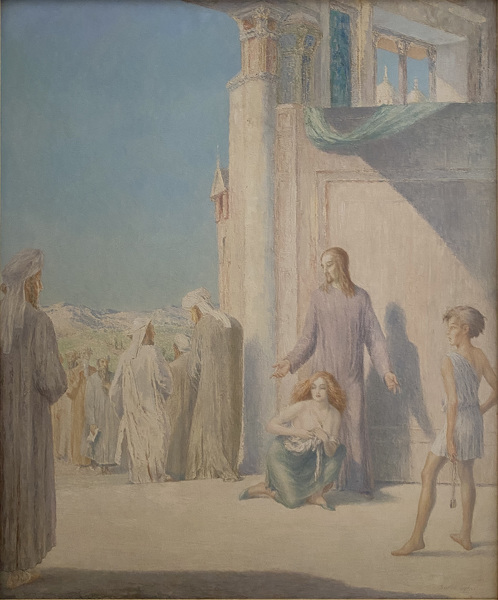
'Christ and the Woman Taken in Adultery', signed (twice) tempera on board, circa 1941
Framed (ref: 10894)
Signed,
Tempera on board

Signed,
Tempera on board
Provenance: .L.M. Avery Esq 1941
The term tempera refers to any painting medium consisting of coloured pigments mixed with a water-soluble binder. Egg tempera, the most common form, consists of pigments bound by egg yolk. On account of its binder, tempera tends to have a matt surface, and, unlike oil, is usually not varnished when finished. Typically painted on a panel prepared with gesso (rather than a canvas), tempera paintings often have sharper defined contours and smoother surfaces. Unlike oil, tempera does not afford areas of impasto (textured paint). Tempera dries fast and therefore colours cannot be blended. Modelling is achieved by laying down innumerable individual brushstrokes of graduated colour adjacent to each other. Many artists working in tempera felt attracted to the labour intensive idea of preparing their own colours, grinding raw pigments with a mortar and pestle.
Although Tempera had been out of favour since the end of the Renaissance, when it was gradually replaced by oil paint, British artists such as William Blake (1757-1827), and the Pre-Raphaelites were passionate advocates of the medium. In 1901 Christiana Herringham (1852-1929) together with Joseph Southall (1861-1944) and Marianne Stokes (1855-1927), formed the Society of Painters in Tempera centred around artists of the Birmingham School: Maxwell Armfield (1881-1972), Arthur Gaskin (1862-1928), Charles March Gere (1869-1957), Margaret Gere (1878-1965), and Frederick Cayley Robinson (1862-1927). In the 20th century, Britain tempera was also popular amongst Rome Scholars and its faculty members, including Charles Sims (1872-1928), Winifred Knights (1899-1947), Thomas Monnington (1902-1976), Reginald Brill (1902-1974), and muralists such as Mary Adshead (1904-1995) and Barbara Jones (1912-1978).
Tempera can survive the passage of time better than oil paintings – this is especially the case with early Italian egg tempera, which is usually characterised by an almost enamelled appearance. In the 20th century however, egg tempera was often only lightly bound (resulting in a chalky quality), closer in character to watercolour.